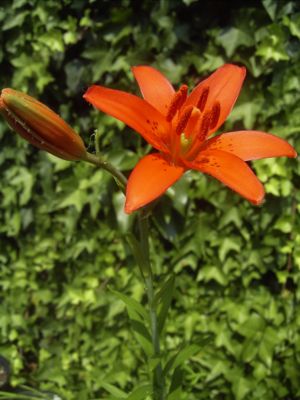Lilium concolor
| Lilium concolor | ||||||||||||
|---|---|---|---|---|---|---|---|---|---|---|---|---|

Lilium concolor var. Pulchellum |
||||||||||||
| Systematics | ||||||||||||
|
||||||||||||
| Scientific name | ||||||||||||
| Lilium concolor | ||||||||||||
| Salisb. |
Lilium concolor is a kind from the genus of the lilies ( Lilium ) in the section Sinomartagon .
description
Lilium concolor reaches a height of 30 to 50, rarely up to 80 centimeters. The onion is egg-shaped, reaches a diameter of 1.5 cm to 3.5 cm and is composed of white, egg-shaped to ovate-lanceolate scales that are between 2 and 3.5 cm long and between 1 and 1.5 (rarely up to 3) Are inches wide. The roots are at the base of the stem, above the bulb . The thin stem is papilous and sometimes tinged with purple. The distributed, three to seven-veined leaves are hairless, linear, 2 to 7, rarely up to 10 centimeters long and 3 to 6, rarely up to 10 millimeters wide. The margins and veins are papillary .
The plant blooms between May and July with 1 to 5 upright and star-shaped flowers in an umbel or panicle . The hermaphrodite flowers are threefold. The six identical, inverted-lanceolate to elongated-round lanceolate bracts are slightly bent back, 2.2 to 5.2 inches long and 4 to 14 millimeters wide. The basic color of the shiny flowers is deep red, depending on the variety either with dark dots or not dotted.
The stamens are about 20 mm long and sticky, the anthers about 7 mm long and from deep red to orange in color, the pollen are red. The ovary is cylindrical, 1 to 1.2 centimeters long and 2.5 to 3 millimeters thick, the stylus is slightly shorter, the scar slightly swollen. The seeds ripen in rectangular seed capsules up to 3.5 cm in size and germinate immediately and epigeously .
The number of chromosomes is 2n = 24.
distribution
Lilium concolor needs a moist soil, it grows best on grassy, sunny slopes, in thickets or damp forests at altitudes between 300 and 2200 m above sea level. NN.
The species is native of the People's Republic of China in the provinces of Hebei , Heilongjiang , Henan , Hubei , Jilin , Liaoning , Shaanxi , Shandong , Shanxi , Yunnan and the Inner Mongolia Autonomous Region , as well as in Japan , South Korea , Mongolia and Siberia .
Systematics
In addition to the nominotypic taxon, there are also varieties :
- Lilium concolor var. Pulchellum (Fischer) rule : tepals slightly smaller, spotted, also found in South Korea ( Kangwŏn-do ) and Russia.
- Lilium concolor var. Megalanthum F. T. Wang & T. Tang : bracts with purple dots, larger than the nominate form (5 to 5.2 centimeters long, 8 to 14 millimeters wide), leaves wider (5 to 10 millimeters). Only native to Jilin , on wet meadows at an altitude of 500 m.
use
Lilium concolor is used in Chinese medicine , a powder made from the dried and ground onion or a wine is said to have a disinfectant effect in water and, when applied to wounds, to stop bleeding.
The flower contains essential oils that are used for the production of perfume, in South Korea it is cultivated as a cut flower.
swell
literature
- Liang Songyun, Minoru N. Tamura: Lilium concolor . In: Wu Zhengyi, Peter H. Raven, Hong Deyuan (eds.): Flora of China . tape 24 . Missouri Botanical Garden Press / Science Press, St. Louis / Beijing 2000, ISBN 978-0-915279-83-8 , pp. 139 ( online [accessed February 3, 2009]).
- Stephen G. Haw: The Lilies of China . Timber Press, Portland 1986, ISBN 978-0-88192-034-5 , pp. 77-79 .
- Young Jin Kim: Lily Industry And Research, And Native Lilium Species In Korea . In: Jong Suk Lee, Mark S. Roh (Eds.): International Symposium on the Genus Lilium: Taejon, Korea August 28 - September 1, 1994 . International Society for Horticultural Science, Wageningen 1996, ISBN 978-90-6605-977-1 , p. 69-79 .
Individual evidence
Web links
- Markus Hohenegger: Lilium concolor. In: The Genus Lilium. Retrieved February 3, 2010 .
